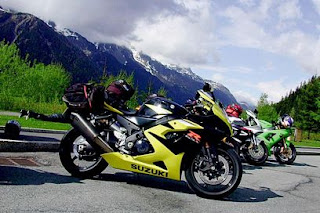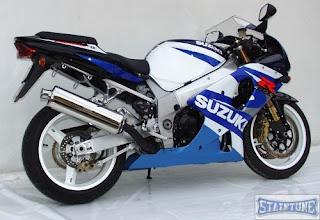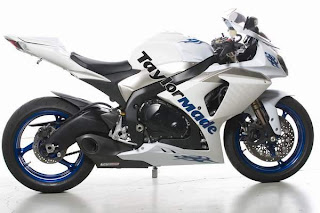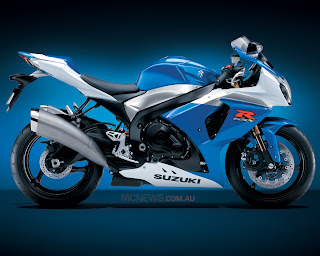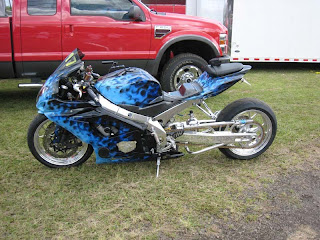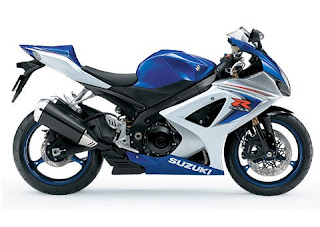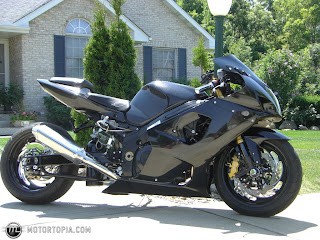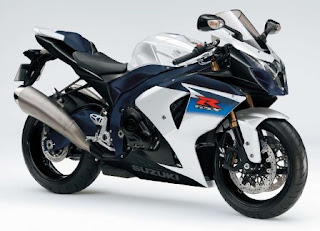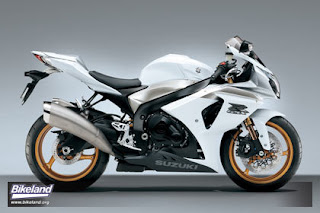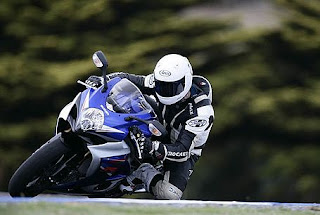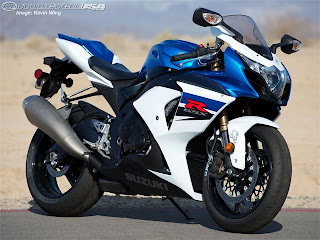Suzuki GSX-R1000
The Suzuki GSX-R1000 is a sport bike from Suzuki's GSX-R series of motorcycles.[1] It was introduced in 2001 to replace the GSX-R1100 and is powered by a liquid-cooled 999 cc (61.0 cu in) inline four-cylinder, four-strokeHistory
2001 (K1, K2)
For 2001, Suzuki introduced a new GSX-R model that replaced the largest and most powerful model of the GSX-R series sport bike, the GSX-R1100, with the all new GSX-R1000. As the model name revealed, the engine's cylinder displacement was roughly 1,000 cc (61 cu in), about 100 cc smaller than its predecessor. The GSX-R1000 was not just an enlarged version of the GSX-R750, although it shared many features with its little brother. The main frame is the same in both models, but the material used on the big brother was .5 mm (0.020 in) thicker. Suzuki claimed the torsional rigidity of the frame had increased 10% in comparison with the GSX-R750.The GSX-R1000 engine was a redesigned GSX-R750 engine. The R1000 had a 1 mm (0.039 in) bigger bore and 13 mm (0.51 in) longer stroke, newly designed pistons with lower crown, and gear-driven counter balancer. The engine weighed 130 lb (59 kg) which was slightly heavier than the 750 engine but 31 lb (14 kg) lighter than the engine of the GSX1300R. The performance of the engine is a peak of 160 bhp (120 kW) at 9,500 rpm, as measured on the crank and 143 hp (107 kW),[2] when measured on the rear wheel with small variations between different instances of the same model. The redline is set at 12,000 rpm. The maximum torque of the engine is 80 ft·lbf (110 N·m) at 8,000 rpm. Combined with a total (dry) weight of 374 lb (170 kg) this gives the GSX-R1000 a top speed of 179 mph (288 km/h), a 1/4 mile time of 10.1 seconds at 141.7 mph (228.0 km/h), and a 0 to 100 km/h (62 mph) time of 3 seconds.
Using titanium for the exhaust down pipe (K1 model link pipe is black, K2 model link pipe is polished titanium) and the inside of the silencer, enabled the 1000s exhaust system to become 4 lb (1.8 kg) lighter than that of the 750.[citation needed] Titanium was also used in the front fork (titanium-nitride) to coat the stanchions. An exhaust tuning valve had been mounted inside the exhaust pipe. Using a servo the system dynamically adjusted the exhaust back pressure, according to engine speed, throttle position, and gear selection for increased torque, lower emissions, and decreased noise—the (stock) exhaust noise of the GSX-R1000 is notably lower than that of the GSX-R600.
With the 2001 model of the GSX-R1000, the 1998 Yamaha YZF-R1 was finally surpassed with the GSX-R being lighter and more powerful.
The 2001 model carried over to 2002 with minimal changes. 2002 introduced i.a. modifications to the fuel pump, clutch, front axle, torque link, mirrors, and luggage hooks. The manual fast-idle was replaced with a computer operated implementation (the "STV servo"). New colours, and new GSXR stickers.
2003 (K3, K4)
After the GSX-R1000 had been three years on the roads and race tracks, Suzuki put out a new version of the model in late September 2002. Suzuki engineers had been working on the three things that made a fast bike faster; weight, power and handling. The 2003 year's GSX-R1000 was improved in all three counts. It weighed less, had more power/torque and handled better.The physical dimensions of the bike were almost identical with the previous year's model. The seat height and the overall height were somewhat lower but the geometry of the bike was exactly the same as before. The already rigid aluminum alloy frame was newly designed and enforced with internal ribs. The frame as well as the wheels were now coated black.
The front brakes were also new. Suzuki decided to drop the six-piston calipers. The new radially mounted four-piston calipers weigh 30 grams less and grip smaller 300 mm (12 in) discs that save another 300 g (0.66 lb). Though smaller, Suzuki claimed that the new brakes provide better stopping and turn-in performance.
The headlights of the 2003 year's GSX-R1000 were mounted vertically to enable the ram-air intakes in the front to be placed 20 mm (0.79 in) nearer the bike's center line. The new design was very much inspired by the look of the Hayabusa. The instruments were also redesigned.
The cylinder displacement of the engine remained the same 988 cc (60.3 cu in), but more power/torque and better throttle response had been achieved by adding four ventilation holes between the cylinders to equalize crankcase pressure beneath the pistons, moving the air intake nearer to the centerline and upgrading the engine management system from a 16-bit to a 32-bit ECU. The entire exhaust system was now made of titanium to save an additional 1.32 lb (0.60 kg) and the tail light was replaced with LEDs.
The 2003 model carried over to 2004 without any significant improvements.
2005 (K5, K6)
The 2005 model year GSX-R1000 had a redesigned engine and chassis. It had 4.4 lb (2.0 kg) lower weight than the previous model and the engine had an 11 cc (0.67 cu in) larger piston displacement. It had a totally new frame reducing the total length of the bike by 1.6 in (41 mm) but reducing its wheelbase only 0.02 in (0.51 mm). There were new brakes with radial mounted calipers and 310 mm (12 in) discs at the front. The new catalytic titanium silencer was said to be designed to reduce turbulence to minimum.The 2005 model has a tested wet weight of 444 lb (201 kg).[4] Power output is tested 162.1 hp (120.9 kW) at 11,500 rpm and peak torque is 79.9 ft·lbf (108.3 N·m) at 8,500 rpm.[4]
The 2005 model carried over to 2006 without any significant improvements.
2007 (K7, K8)
On September 22, 2006, Suzuki revealed a significantly updated GSX-R1000 for 2007 at the Paris motor show. The new bike gained 14 lb (6.4 kg) over the 2006 model which was due to its new exhaust system and new emissions regulations. To counter this weight increase, Suzuki claimed improved aerodynamics along with a faster revving engine and larger throttle body to increase power to 168 hp (125 kW) @ 11,500 rpm. Although not a completely new model, the engine and chassis have been updated. It also featured three different engine mapping configurations, selectable via two buttons located on the right handlebar. One up, and one down arrow to cycle between Mode A (unrestricted), Mode B (reduced power until 50% throttle is applied), and Mode C (reduced power throughout the rpm regardless of throttle application). It also received a hydraulic clutch.The 2007 model carried over to 2008 without any significant improvements.
Specifications
| 2001–2002 | 2003–2004 | 2005–2006 | 2007–2008 | 2009–2011 | |
|---|---|---|---|---|---|
| Engine | 988 cc (60.3 cu in), 4-stroke, four-cylinder, liquid-cooled, DOHC 16-valve, TSCC | 998.6 cc (60.94 cu in), 4-stroke, four-cylinder, liquid-cooled, DOHC, 16-valve, TSCC | 999 cc (61.0 cu in), 4-stroke, four-cylinder, liquid-cooled, DOHC, 16-valve, TSCC | ||
| Bore Stroke: | 73.0 mm (2.87 in) x 59.0 mm (2.32 in) | 73.0 mm (2.87 in) x 59.0 mm (2.32 in) | 73.4 mm (2.89 in) x 59.0 mm (2.32 in) | 74.5 mm (2.93 in) x 57.3 mm (2.26 in)[6] | |
| Compression Ratio: | 12.0:1 | 12.0:1 | 12.5:1 | 12.8:1[6] | |
| Power (crank) | 160 hp (120 kW) @ 10,800 rpm | 162 hp (121 kW) @ 10,800 rpm | 178 hp (133 kW) @ 11,000 rpm | 185 hp (138 kW) @ 12,000 rpm | 191 hp (142 kW) @ 12,000 rpm |
| Fuel System: | Fuel Injection | ||||
| Lubrication: | Wet Sump | ||||
| Ignition: | Digital/transistorized | ||||
| Transmission: | 6-speed, constant mesh | 6-speed, constant mesh, Back-torque limiting clutch | |||
| Final Drive: | #530 chain(110 links) 17T / 42T | ||||
| Overall Length: | 2,045 mm (80.5 in) | 2,070 mm (81 in) | 2,030 mm (80 in) | 2,045 mm (80.5 in) | |
| Overall Width: | 715 mm (28.1 in) | 715 mm (28.1 in) | 710 mm (28 in) | 720 mm (28 in) | 710 mm (28 in) |
| Overall Height: | 1,135 mm (44.7 in) | 1,145 mm (45.1 in) | 1,130 mm (44 in) | ||
| Seat Height: | 830 mm (33 in) | 820 mm (32 in) | 810 mm (32 in) | ||
| Ground Clearance: | 130 mm (5.1 in) | 125 mm (4.9 in) | 120 mm (4.7 in) | ||
| Wheelbase: | 1,410 mm (56 in) | 1,405 mm (55.3 in) | 1,415 mm (55.7 in) | 1,405 mm (55.3 in) | |
| Dry Weight: | 374 lb (170 kg) | 370.4 lb (168.0 kg) | 365 lb (166 kg) | 379 lb (172 kg) | |
| Wet Weight: | 443 lb (201 kg)[citation needed] | 444 lb (201 kg)[citation needed] | 446 lb (202 kg) | 448 lb (203 kg) | |
| Suspension Front: | Kayaba 43 mm (1.7 in) Inverted telescopic, coil spring, oil damped, spring pre-load fully adjustable, rebound compression damping force adjustable. | Kayaba 43 mm (1.7 in) Inverted telescopic forks with DLC coating, spring preload, rebound and compression adjustment | Inverted telescopic, coil spring, fully adjustable spring preload, compression and rebound damping | Inverted telescopic, coil spring, fully adjustable spring preload, high & low speed compression and rebound damping | Showa Inverted telescopic, coil spring, fully adjustable spring preload, high & low speed compression and rebound damping/New electronically controlled steering damper uses a solenoid valve to move a tapered needle reducing or increasing oil flow to adjust damping force. |
| Suspension Rear: | Link type, gas/oil damped, coil spring, spring pre-load fully adjustable, rebound damping force and compression damping force adjustable | Link type, coil spring, oil damped, adjustable spring preload, compression and rebound damping | Link-type, gas/oil-damped, fully adjustable spring preload, compression and rebound damping | Link-type, gas/oil-damped, fully adjustable spring preload, high & low speed compression and rebound damping | |
| Brakes Front: | Twin semi floating stainless discs 320 mm (13 in) and Tokico 6 piston calipers | Twin 300 mm (12 in) semi floating stainless discs and Tokico 4 piston radial mounted calipers | Dual hydraulic disc | ||
| Brakes Rear: | Single disc 220 mm (8.7 in) and Tokico dual piston caliper | Single 220 mm (8.7 in) disc and a dual piston caliper | Single hydraulic disc | ||
| Tires Front: | 120/70-ZR-17 | ||||
| Tires Rear: | 190/50-ZR-17 | ||||
| Fuel Tank Capacity: | 18 L (4.0 imp gal; 4.8 US gal) | ||||
courtsey by:http://en.wikipedia.org/wiki/Suzuki_GSX-R1000











